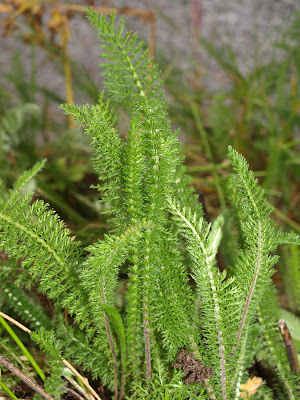Spring continues to be a very dry season this year. The leaves on our beech trees have not filled out as much as they normally do, leaving the trees looking rather thin. Thankfully we have a stream running through our land so the wildlife has plenty of water available. However, away from this riparian area is a very different story. The normally lush green fields are looking as if they have emerged from a long hard winter
The
stinging nettles (Urtica dioica)
were late emerging this year but are now producing a decent crop for the table. We use them as a lightly cooked green vegetable, in soups,
pesto and smoothies. If they become too old and begin to flower, we scythe them back to produce a fresh young crop. This can be done throughout the year. However, plants may become successively smaller.
 |
| Rowan blossom tea |
June sees the blossoming of the
rowan (Sorbus aucuparia),
one of our favourite trees. The blossom of and leaves are highly perfumed and can be made into a tea. The rowan is a great tree for
wildlife. The leaves are eaten by caterpillars and moths. The flowers provide pollen and nectar for pollinating insects including bees. The fruit is popular in the autumn and winter months as a food source for birds.
 |
| High perfumed rowan blossom |
Elder (Sambucus nigra) is also in blossom at this time of year. The frothy crunchy clusters of pale yellow flowers are edible raw and have a very delicate flavour. They are popularly used to make tea,
cordial or champagne. They look particularly good decorating cakes and fruit salads. The flowers dry very well and can be stored in an airtight container for later use. Elder has a long history of use in herbal medicine and is particularly popular in remedies for colds and flu
Hawthorn (Crataegus monogyna)
leaves are filling out in the hedgerows. Hawthorn has raw edible flowers, flower buds, leaves, young shoots and fruit. The leaves and flowers can be made into a health-giving tea. The leaves have a
nutty flavour and can be quite filling.
 |
| Hawthorn blossom and leaves by Amanda Slater |
Another tree in blossom at this time of the year is the
small-leaved lime (Tilia cordata) tree. The young lime flowers are edible raw and can be made into a fragrant calming tea which is very popular. It is often sold as linden tea. Take care if using older flowers to make tea as they may be a narcotic.
T. cordata bears no relation to the lime (
Citrus aurantifolia) which is a citrus fruit!
The young heart-shaped leaves of all
Tilia species are generally
considered edible raw but the small-leaved lime is probably the best.
Leaves have a good texture with a mild and slightly sweet flavour. They are
excellent in salads and can be used in much the same way as lettuce.
 |
| Lime leaves on a young tree |
Other green leaves which are available now for use in salads including
Self heal (Prunella vulgaris),
yarrow (Achillea millefolium),
daisy (Bellis perennis),
dandelion (Taraxacum officinale),
common sorrel (Rumex acetosa), hairy bittercress (
Cardamine hirsuta), shepherd's purse (
Capsella bursa-pastoris),
chickweed (Stellaria media),
cleavers (Galium aparine),
mallow (Malva species) and garlic mustard (
Alliaria officinalis or
petiolata).
 |
| The bitter leaves of the yarrow plant |
Ox-eye daisies (Leucanthemum vulgare) are beginning to flower now. All the aerial parts are edible raw. The flowers and leaves can be used in salads and the flower buds can be pickled like capers. Many references say to eat the petals only on the flower but we find the whole flower very tasty although too can make your tongue numb! The fresh or dried leaves and flowers can also be used to make a
tea.
 |
| Ox-eye daisies |
Daisies (Bellis perennis) are easily found and identified in gardens throughout the British Isles. Smaller than the ox-eye, they often pop up in lawns. The flower buds, petals and leaves are edible raw and can be made into a
tea. They are great for salads. The open flowers are very decorative but can be slightly bitter or acrid. Flower buds can be pickled and used instead of capers. The leaves (think lamb's lettuce) have an astringent or sour flavour.
 |
| The flowers and leaves of the daisy are edible raw |
Happy foraging!






